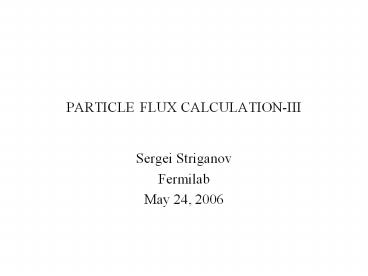PARTICLE FLUX CALCULATION-III - PowerPoint PPT Presentation
Title:
PARTICLE FLUX CALCULATION-III
Description:
PARTICLE FLUX CALCULATION-III. Sergei Striganov. Fermilab. May 24, 2006 ... gammas (E 200 keV) Energy spectra ( 0 degree detector) ... – PowerPoint PPT presentation
Number of Views:20
Avg rating:3.0/5.0
Title: PARTICLE FLUX CALCULATION-III
1
PARTICLE FLUX CALCULATION-III
- Sergei Striganov
- Fermilab
- May 24, 2006
2
Detector positions and particle fluxes per pulse
(3 1013 protons).
neutrons (Egt100 keV)
charged hadrons (Egt200 keV)
3
Detector positions and particle fluxes per pulse
(3 1013 protons).
electrons (Egt200 keV)
gammas (Egt200 keV)
4
Energy spectra ( 0 degree detector). Blue lines
all particles, red lines- particles created in
attenuator.
5
Energy spectra ( 6.7 degree detector). Blue lines
all particles, red lines- particles created in
attenuator.
6
Energy spectra ( 11.5 degree detector). Blue
lines all particles, red lines- particles
created in attenuator.
7
Energy spectra ( 45 degree detector). Blue lines
all particles, red lines- particles created in
attenuator.
8
Particle fluxes per pulse (3 1013 protons).
Charged pions (pgt5GeV/c)
Electrons (pgt18 MeV/c)
9
Neutral particles background. Particle fluxes per
pulse (3 1013 protons).
gammas (Egt200 keV)
neutrons (Egt100 keV)
10
Shielding efficiency.Electron flux (pgt18MeV/c)
per pulse (3 1013 protons).
4 cm Pb shield
1cm Pb shield
11
Energy spectra
12
Electrons and charged pions in cherenkov detector
13
Conclusions
- To estimate signal/background ratio in
scintillator detectors we need to specify
efficiency of detector as function of energy and
particle type - It is possible to obtain reasonable
signal/background ratio in cherenkov detector
using lead shielding. More detailed calculations
(including simulation of cherenkov light?) is
needed.

